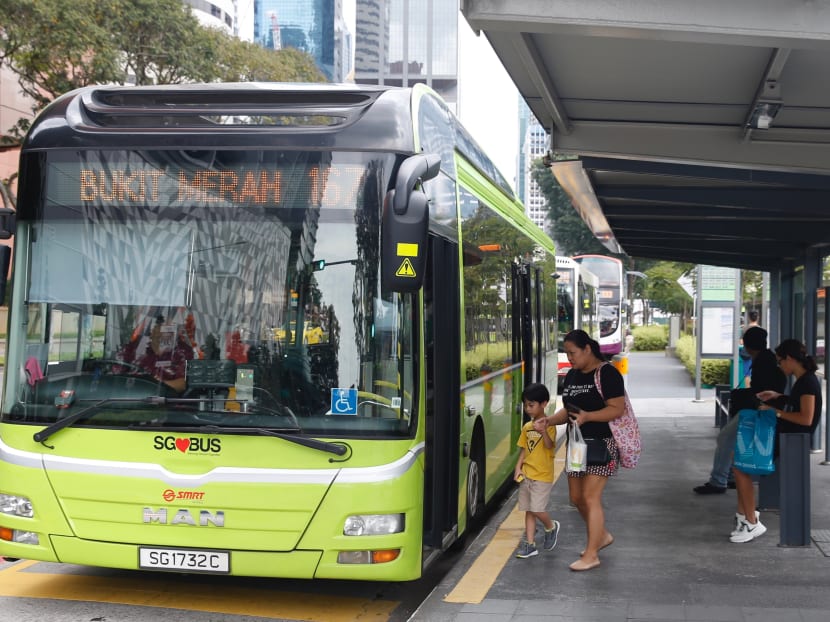Land Transport Master Plan 2040: Faster journeys for cyclists, bus passengers at priority corridors
SINGAPORE — Bus commuters will shave minutes off their journeys in the next decade, as the authorities mull over features such as bus-only roads in certain areas such as Robinson Road and Jurong Lake District.
SINGAPORE — Bus commuters will shave minutes off their journeys in the next decade, as the authorities mull over features such as bus-only roads in certain areas such as Robinson Road and Jurong Lake District.
These features, which may also include smarter traffic light control systems, will go beyond the typical bus lanes on Singapore’s roads currently. The aim: To improve bus speeds.
Cyclists and personal mobility device users could also have a smoother, faster ride with dedicated cycling paths alongside bus lanes at these transport priority corridors.
Besides Robinson Road and Jurong Lake District, other areas under study include Loyang, Tengah and Woodlands North Coast, said the Land Transport Authority (LTA) on Saturday (May 25) as it released the Land Transport Master Plan 2040 report.
The North-South Corridor running from northern Singapore to the city centre, which will be completed in 2026, will be Singapore’s longest transport priority corridor, said the LTA. Bus passengers along the stretch will be able to cut travel times by up to 15 minutes.
The only existing corridor at Bencoolen Street was introduced in 2017, when it was repurposed by reclaiming lanes to prioritise public transport and active mobility.
It features a fully dedicated bus lane, a purpose-built cycling path with 125 accompanying bicycle lots and wider pedestrian spaces.
Here are other measures to improve connections for commuters:
MORE INTEGRATED BUS HUBS
More integrated transport hubs, where bus interchanges are integrated with malls, will be built islandwide, bringing the total number to 21.
Integrated hubs are being planned in Beauty World, Bedok South, Hougang, Jurong East, Marina South, Pasir Ris, Tampines North and Tengah, said the LTA.
Five hubs are already under construction in places such as Bidadari, Buangkok and Punggol North. There are nine existing hubs.
Such hubs give commuters access to amenities as part of their public transport journey while providing more seamless connections between buses and trains, LTA said.
ON-DEMAND SERVICES
To reduce travel and waiting times, the LTA plans to deploy autonomous, on-demand, dynamically-routed buses as part of a pilot programme.
Trials will be carried out in Punggol, Tengah and the Jurong Innovation District in the early 2020s.
Similar trials are currently taking place in Joo Koon and Marina Downtown, but the new trials will involve autonomous vehicles.
Dynamically-routed services adjust their routes based on passenger demand, enabling commuters to make fewer transfers while optimising transport resources, said LTA.
“When paired with autonomous vehicle technology, there is further potential to reduce operating and manpower costs.”
EXPANDED CYCLING NETWORK
More than 300km of cycling paths will be added to the 700km that will be completed by 2030.
The new paths will expand the cycling path network to over 1,000km by 2040.
In new precincts such as Kampong Bugis, Tengah and Woodlands North Coast, there are also plans to build cycling paths on both sides of the road.
New cycling paths may be added in private residential areas and industrial estates, added the LTA.
CLEANER FLEETS
To reduce the carbon footprint of public transport, all public buses will run on cleaner energy by 2040, comprising alternatives such as electric or hybrid vehicles.
LTA has already awarded a tender for 60 electric buses, which will be progressively deployed for service by 2020.
Trials with 50 diesel-hybrid vehicles have been conducted since end-2018, and LTA will assess if they perform well and are cost-effective. More will be bought if the trials are successful.
All local taxi companies have committed to having cleaner vehicles by 2040.
Taxi firm HDT is already operating a fleet of fully electric taxis and aims to expand its fleet size to at least 800 by 2021, said LTA.
Some private-hire car booking providers and rental companies have pledged to have their entire fleet run on cleaner energy by 2040.
Companies like Grab already have electric vehicles in their existing fleets.
“Collectively, these efforts will significantly improve air quality and noise pollution in Singapore,” said LTA.







